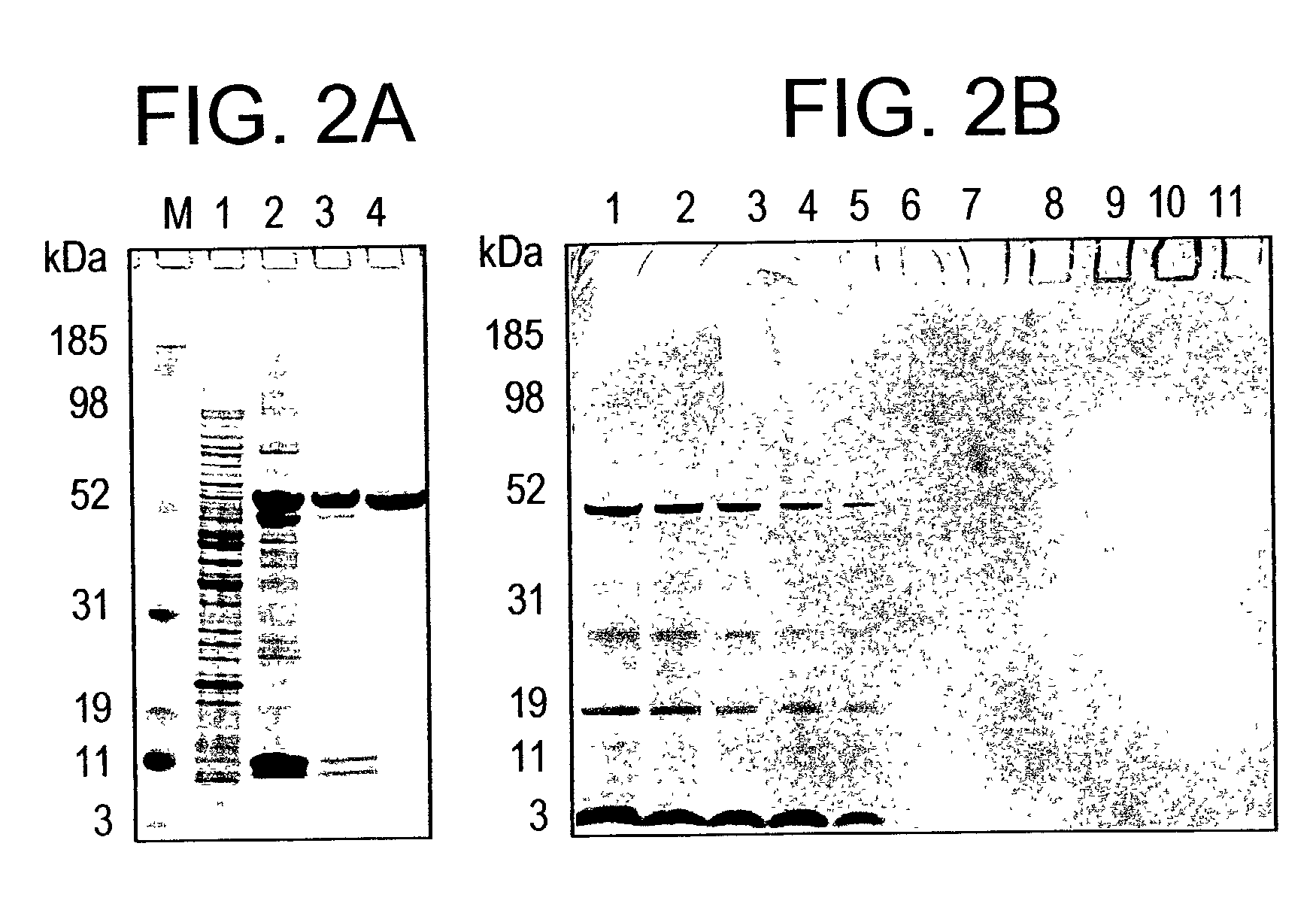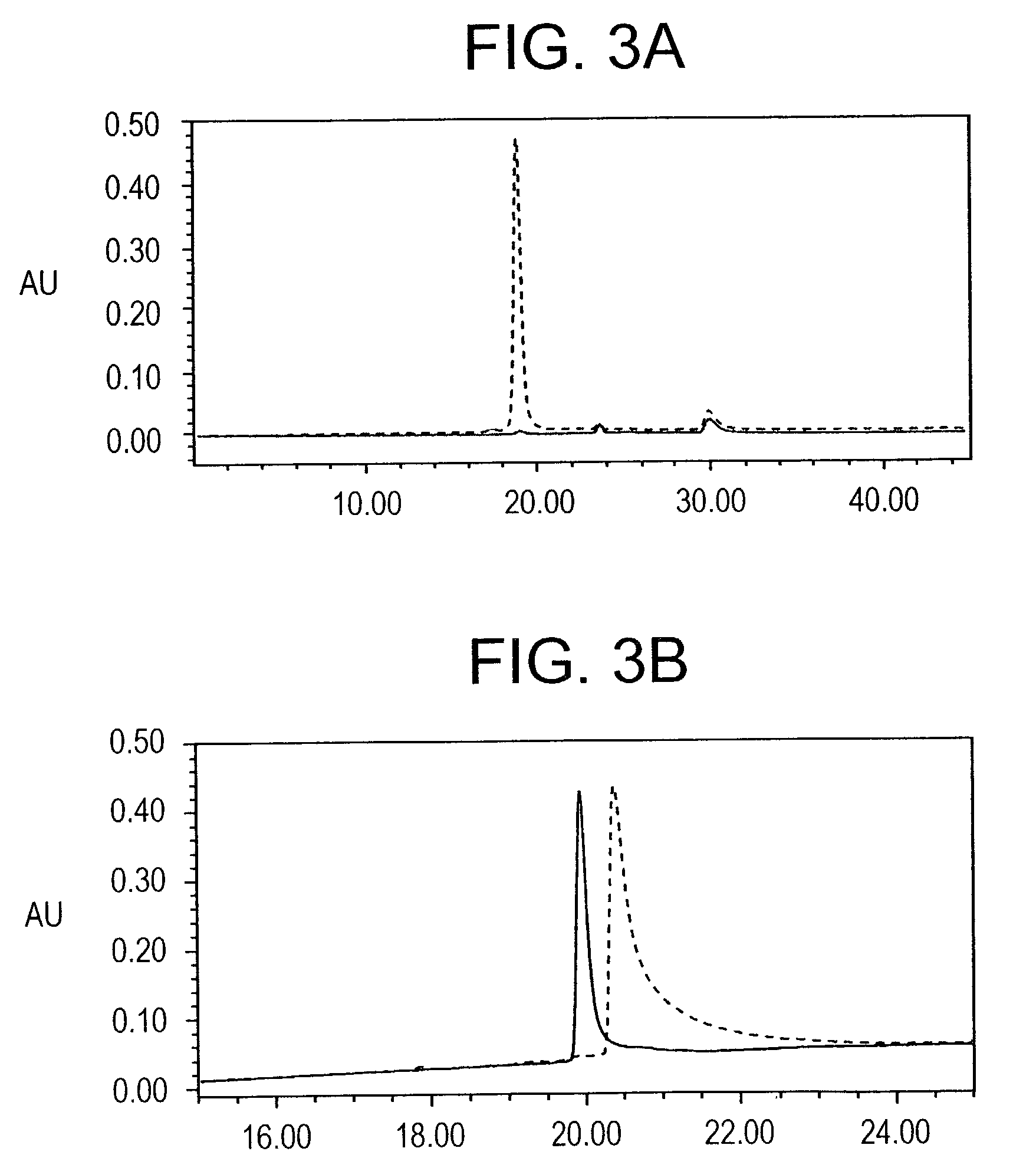Plasmodium falciparum AMA-1 protein and uses thereof
- Summary
- Abstract
- Description
- Claims
- Application Information
AI Technical Summary
Benefits of technology
Problems solved by technology
Method used
Image
Examples
example 1
[0191]Fermentation of E. coli Origami (DE3) expressing the r-AMA1 / E protein at 10 L and 300 L scale: The synthetic gene cloned in the vector pWRMAL was sequenced and the translation of this gene sequence revealed no amino acid changes from the published 3D7 clone sequence (GenBank™ Accession No U65407.1). Fermentation conditions were developed in a 10 L bioreactor and later scaled-up to a 300 L GMP fermentation. The 10 L fermentation routinely resulted in 150 gm cell paste while the 300 L fermentation resulted in 4.5 kg cell paste. The final plasmid stability for the GMP fermentation was 36%. Although the use of Origami (DE3) increased the proportion of r-AMA1 / E in the soluble fraction (compared to the conventional BL21 (DE3) strain), protein fractionation experiments showed that a majority of r-AMA1 / E was still localized in the insoluble fraction (data not shown).
example 2
[0192]Extraction of r-AMA1 / E in sarkosyl and its enrichment by Ni+2 affinity chromatography: Aliquots were taken from the GMP cell paste lot and a scalable refolding and purification process was developed. During cell lysis soluble and insoluble forms of r-AMA1 / E were extracted with buffer containing 5% sarkosyl. The r-AMA1 / E constituted ˜1–2% of total cell protein estimated by laser densitometry of a SDS-PAGE run under reduced conditions (FIG. 2A, lane 1). Following the first step of purification over Ni+2 column, r-AMA1 / E was enriched to ˜40% of total protein (FIG. 2A, lane 2). A large fraction of r-AMA / E present in the Ni+2 elution, was aggregated as seen on a non-reduced SDS-PAGE (data not shown).
example 3
[0193]Optimization of the refolding conditions: In order to find the optimal refolding conditions, the Ni+2 elution was subjected to rapid dilution in refolding buffers of varying GSH / GSSG ratios, at pH 8.0, in phosphate buffer. Serial dilutions of these test refolding mixtures were coated on a microtiter plate and ELISA reactivity against the conformation specific, inhibitory, monoclonal antibody 4G2dc1, was used as a measure of folding efficiency; while the reactivity to a monoclonal anti-hexa-histidine antibody was used to confirm equivalent coating efficiency. Ratios of GSH / GSSG tested for refolding included 1 / 0.1 mM, 1 / 0.25 mM, 1 / 1 mM, and 0.1 / 1 mM respectively, while phosphate buffer containing EDTA (pH 8.0) alone was used as a control. The GSH / GSSG ratios of 1 / 0.1 mM and 1 / 0.25 mM were found to be equally efficient, both of which gave 4G2dc1 reactivity about 5 times higher than the phosphate buffer control. As the GSH / GSSG ratio of 1 / 0.25 mM had been previously reported for e...
PUM
| Property | Measurement | Unit |
|---|---|---|
| Fraction | aaaaa | aaaaa |
| Fraction | aaaaa | aaaaa |
| Fraction | aaaaa | aaaaa |
Abstract
Description
Claims
Application Information
 Login to View More
Login to View More - R&D
- Intellectual Property
- Life Sciences
- Materials
- Tech Scout
- Unparalleled Data Quality
- Higher Quality Content
- 60% Fewer Hallucinations
Browse by: Latest US Patents, China's latest patents, Technical Efficacy Thesaurus, Application Domain, Technology Topic, Popular Technical Reports.
© 2025 PatSnap. All rights reserved.Legal|Privacy policy|Modern Slavery Act Transparency Statement|Sitemap|About US| Contact US: help@patsnap.com



